Page 21 of 320
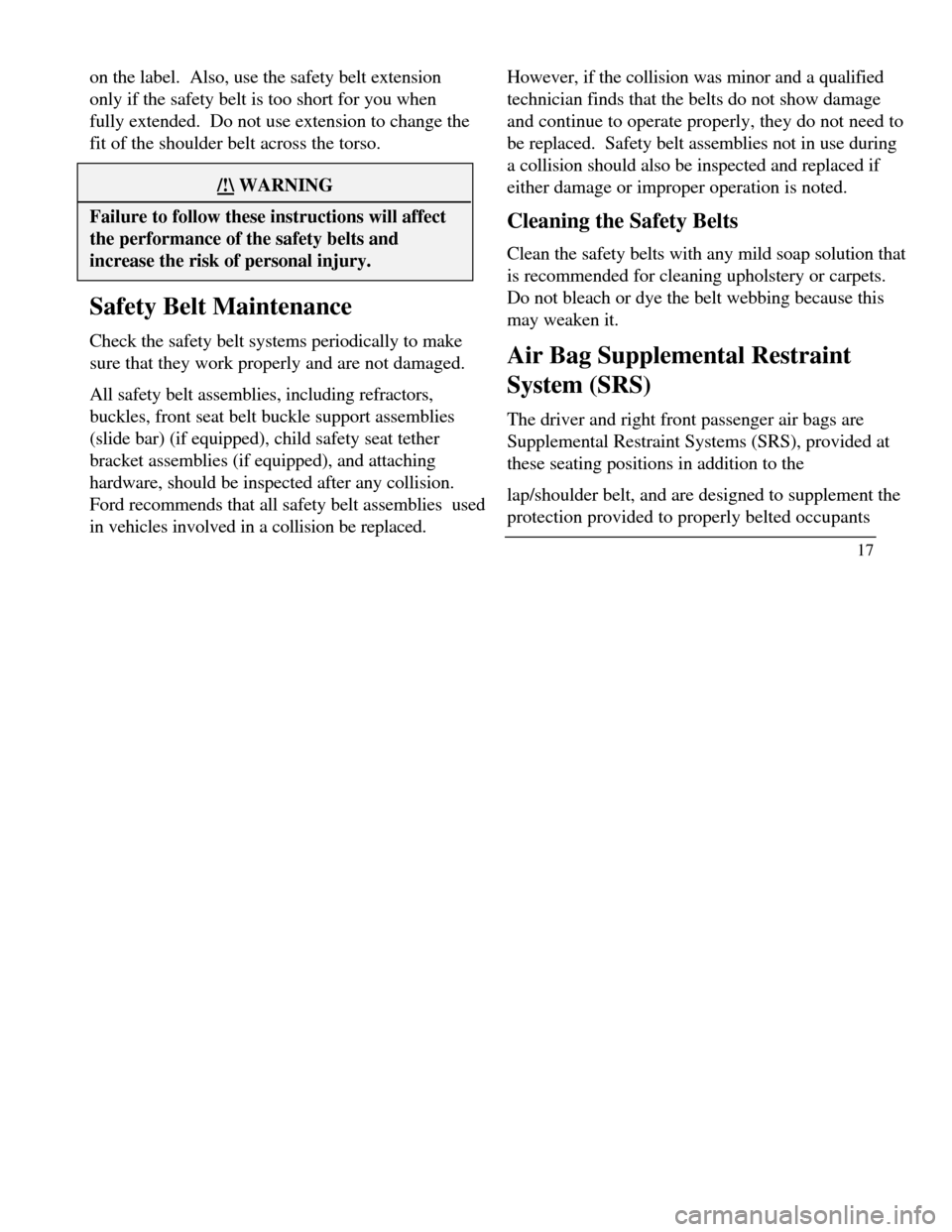
on the label. Also, use the safety belt extension
only if the safety belt is too short for you when
fully extended. Do not use extension to change the
fit of the shoulder belt across the torso./!\ WARNINGFailure to follow these instructions will affectthe performance of the safety belts andincrease the risk of personal injury.Safety Belt Maintenance
Check the safety belt systems periodically to make
sure that they work properly and are not damaged.
All safety belt assemblies, including refractors,
buckles, front seat belt buckle support assemblies
(slide bar) (if equipped), child safety seat tether
bracket assemblies (if equipped), and attaching
hardware, should be inspected after any collision.
Ford recommends that all safety belt assemblies used
in vehicles involved in a collision be replaced.However, if the collision was minor and a qualified
technician finds that the belts do not show damage
and continue to operate properly, they do not need to
be replaced. Safety belt assemblies not in use during
a collision should also be inspected and replaced if
either damage or improper operation is noted.
Cleaning the Safety Belts
Clean the safety belts with any mild soap solution that
is recommended for cleaning upholstery or carpets.
Do not bleach or dye the belt webbing because this
may weaken it.
Air Bag Supplemental Restraint
System (SRS)
The driver and right front passenger air bags are
Supplemental Restraint Systems (SRS), provided at
these seating positions in addition to the
lap/shoulder belt, and are designed to supplement the
protection provided to properly belted occupants
17
Page 22 of 320
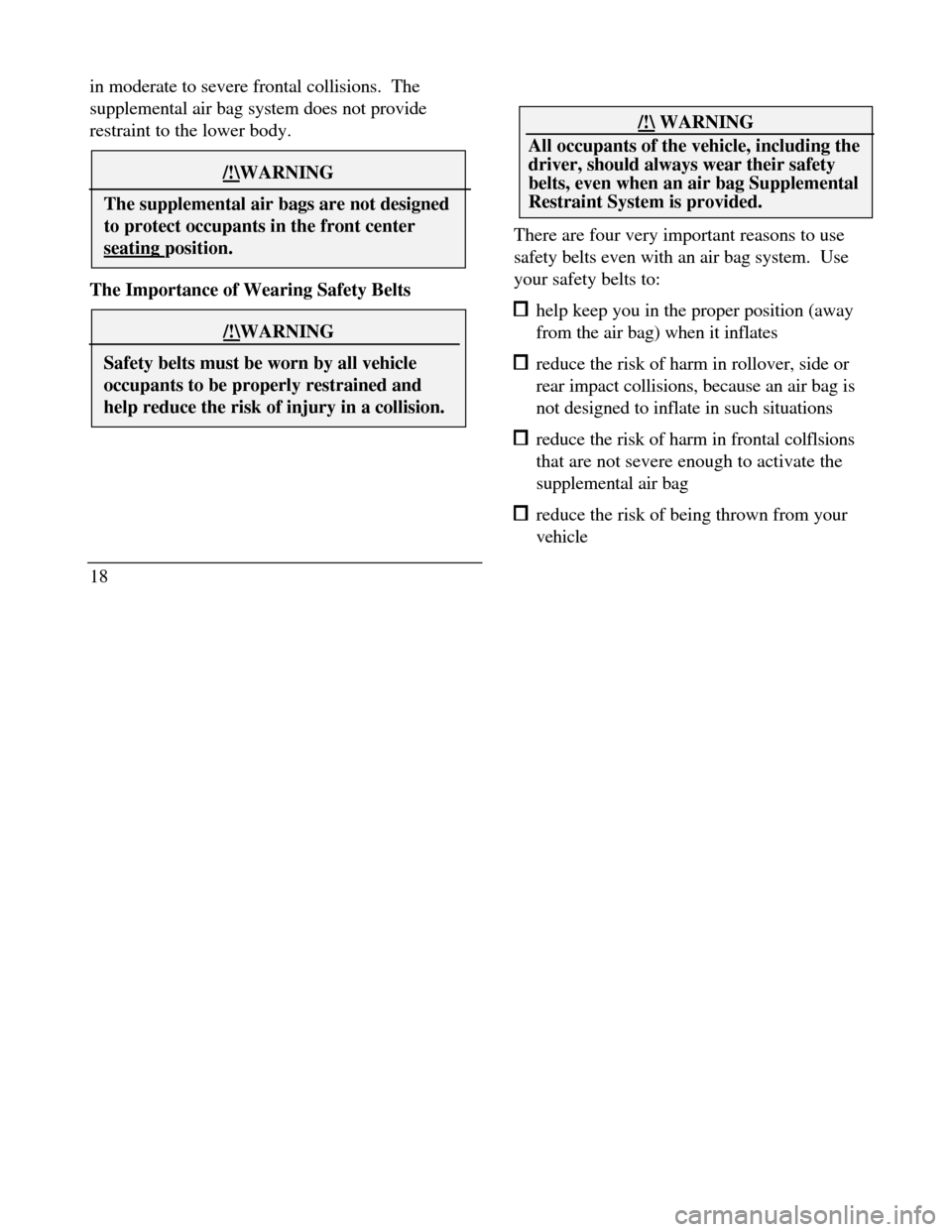
in moderate to severe frontal collisions. The
supplemental air bag system does not provide
restraint to the lower body./!\WARNINGThe supplemental air bags are not designedto protect occupants in the front centerseating position.The Importance of Wearing Safety Belts/!\WARNINGSafety belts must be worn by all vehicleoccupants to be properly restrained andhelp reduce the risk of injury in a collision.18/!\ WARNINGAll occupants of the vehicle, including thedriver, should always wear their safetybelts, even when an air bag SupplementalRestraint System is provided.There are four very important reasons to use
safety belts even with an air bag system. Use
your safety belts to: help keep you in the proper position (away
from the air bag) when it inflates reduce the risk of harm in rollover, side or
rear impact collisions, because an air bag is
not designed to inflate in such situations reduce the risk of harm in frontal colflsions
that are not severe enough to activate the
supplemental air bag reduce the risk of being thrown from your
vehicle
Page 23 of 320

The Importance of Being Properly
Seated
In a collision, the air bag must inflate extremely
fast to help provide additional protection for
you. In order to do this, the air bag must inflate
with considerable force. If you are not seated in
a normal riding position with your back against
the seatback, the air bag may not protect you
properly and could possibly hurt you as it
inflates./!\ WARNINGIf a passenger is not properly seated andrestrained, an inflating air bag couldcause serious injury.In rear-facing infant seats, the infant's head is closer
to the air bag. The force of the rapidly inflating air
bag could push the top of the rear-facing seat
against the vehicle seatback or center armrests (if so
equipped), or center console (if so equipped).
Children weighing less than 40 lbs. (18 kg.) should
use child or infant seats. Forward facing child seats
must have the passenger seat moved as far back
from the instrument panel as possible.
Your vehicle is equipped with a right front
passenger air bag. Front passengers, especially
children and small adults, should never sit on the
edge of the seat, stand near the glove compartment
of the instrument panel, or lean over with their
faces near the glove compartment when the vehicle
is moving. All occupants should sit with their backs
against the seatback and use the safety belts.
19
Page 24 of 320

/!\ WARNINGREAR-FACING INFANT SEATSSHOULD NEVER BE USED IN THEFRONT SEAT. REAR-FACINGINFANT SEATS MUST ALWAYS BEPLACED IN THE REAR SEAT. Failureto follow these instructions could result inserious injury./!\ WARNINGDo not place objects or mount equipmenton or near the air bag cover on thesteering wheel or in front seat areas thatmay come in contact with a deploying airbag. Failure to follow this instructionmay increase the risk of personal injury inthe event of a collision.20For further information about the proper mounting
of equipment in the front seat of this vehicle, please
refer to Ford's brochure entitled Some Important
Information About Air Bag Supplemental Restraint
System which can be obtained by calling Helm Inc.
at 1-800-782-4356. Ask for brochure FPS-8602.
For additional important safety information on the
proper use of seat belts, child seats, and infant seats,
please read the other sections of this part of the
Owner Guide, especially sections entitled Safety
Belts for Children and Safety Seats for Children.
How the Air Bag Supplemental Restraint
System Operates
The Air Bag Supplemental Restraint System
consists of the Driver and Passenger air bags,
impact sensors, a system diagnostic module, a
readiness light and tone, and the electrical wiring
which connects the components.
Page 29 of 320
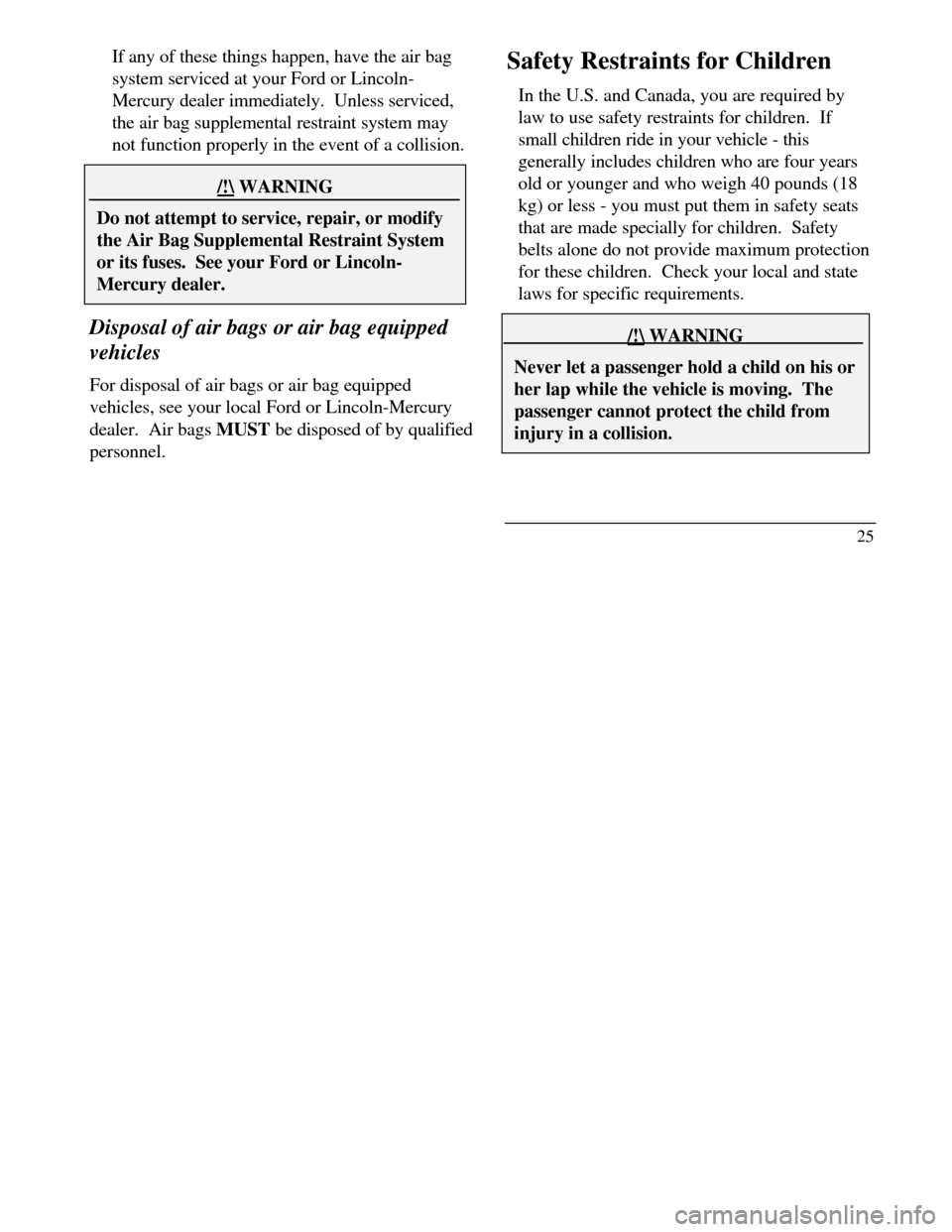
If any of these things happen, have the air bag
system serviced at your Ford or Lincoln-
Mercury dealer immediately. Unless serviced,
the air bag supplemental restraint system may
not function properly in the event of a collision./!\ WARNINGDo not attempt to service, repair, or modifythe Air Bag Supplemental Restraint Systemor its fuses. See your Ford or Lincoln-Mercury dealer.Disposal of air bags or air bag equipped
vehicles
For disposal of air bags or air bag equipped
vehicles, see your local Ford or Lincoln-Mercury
dealer. Air bags MUST be disposed of by qualified
personnel.Safety Restraints for Children
In the U.S. and Canada, you are required by
law to use safety restraints for children. If
small children ride in your vehicle - this
generally includes children who are four years
old or younger and who weigh 40 pounds (18
kg) or less - you must put them in safety seats
that are made specially for children. Safety
belts alone do not provide maximum protection
for these children. Check your local and state
laws for specific requirements./!\ WARNINGNever let a passenger hold a child on his orher lap while the vehicle is moving. Thepassenger cannot protect the child frominjury in a collision.25
Page 30 of 320
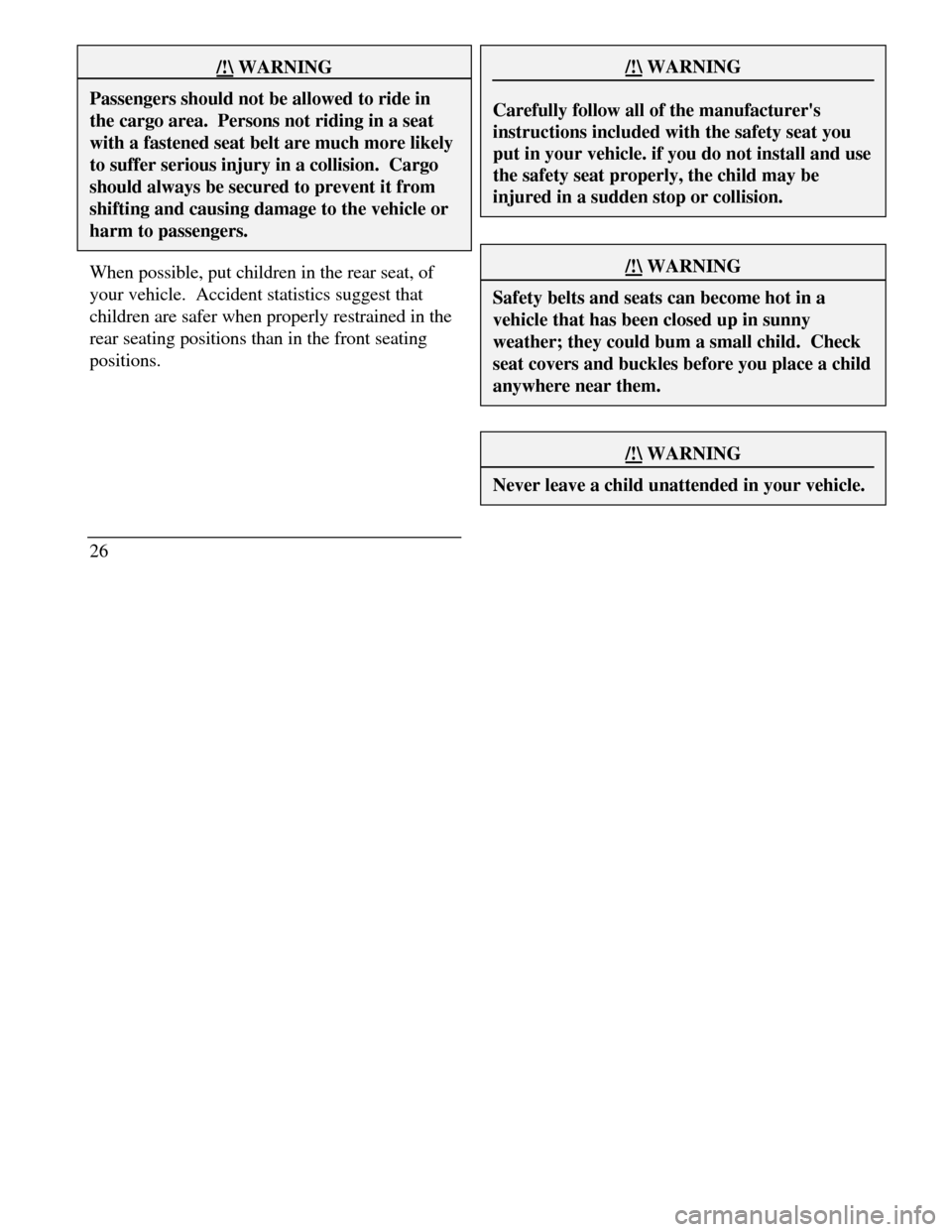
/!\ WARNINGPassengers should not be allowed to ride inthe cargo area. Persons not riding in a seatwith a fastened seat belt are much more likelyto suffer serious injury in a collision. Cargoshould always be secured to prevent it fromshifting and causing damage to the vehicle orharm to passengers.When possible, put children in the rear seat, of
your vehicle. Accident statistics suggest that
children are safer when properly restrained in the
rear seating positions than in the front seating
positions.
26/!\ WARNINGCarefully follow all of the manufacturer'sinstructions included with the safety seat youput in your vehicle. if you do not install and usethe safety seat properly, the child may beinjured in a sudden stop or collision./!\ WARNINGSafety belts and seats can become hot in avehicle that has been closed up in sunnyweather; they could bum a small child. Checkseat covers and buckles before you place a childanywhere near them./!\ WARNINGNever leave a child unattended in your vehicle.
Page 31 of 320
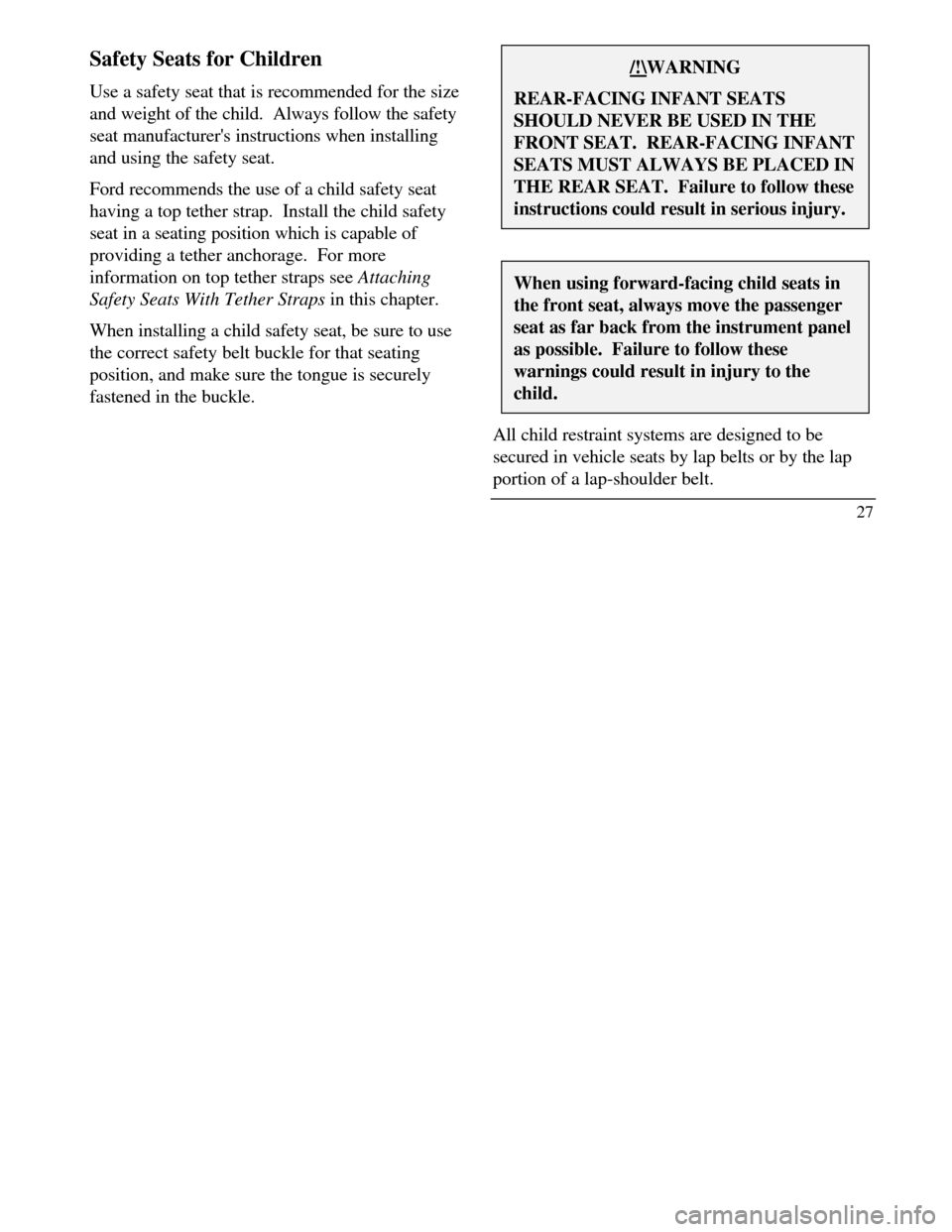
Safety Seats for Children
Use a safety seat that is recommended for the size
and weight of the child. Always follow the safety
seat manufacturer's instructions when installing
and using the safety seat.
Ford recommends the use of a child safety seat
having a top tether strap. Install the child safety
seat in a seating position which is capable of
providing a tether anchorage. For more
information on top tether straps see Attaching
Safety Seats With Tether Straps in this chapter.
When installing a child safety seat, be sure to use
the correct safety belt buckle for that seating
position, and make sure the tongue is securely
fastened in the buckle./!\WARNINGREAR-FACING INFANT SEATSSHOULD NEVER BE USED IN THEFRONT SEAT. REAR-FACING INFANTSEATS MUST ALWAYS BE PLACED INTHE REAR SEAT. Failure to follow theseinstructions could result in serious injury.When using forward-facing child seats inthe front seat, always move the passengerseat as far back from the instrument panelas possible. Failure to follow thesewarnings could result in injury to thechild.All child restraint systems are designed to be
secured in vehicle seats by lap belts or by the lap
portion of a lap-shoulder belt.
27
Page 33 of 320
Safety belt buckle placement for child seatsInstalling Safety Seats in the Front and
Rear Seating Positions
Your vehicle is equipped with a dual locking mode
retractor on the shoulder belt portion of the
combination lap/shoulder safety belt for the front
seat passenger and rear passengers.
If you choose to install a child safety seat in the
front seating position, move vehicle seat as far
back as possible.
For seating positions equipped with a dual-locking
mode retractor, use the following procedure:
1. Position the child seat in center of passenger
seat.
2. Pull down on shoulder belt, then grasp
shoulder belt and lap belt together. Figure 1.
29